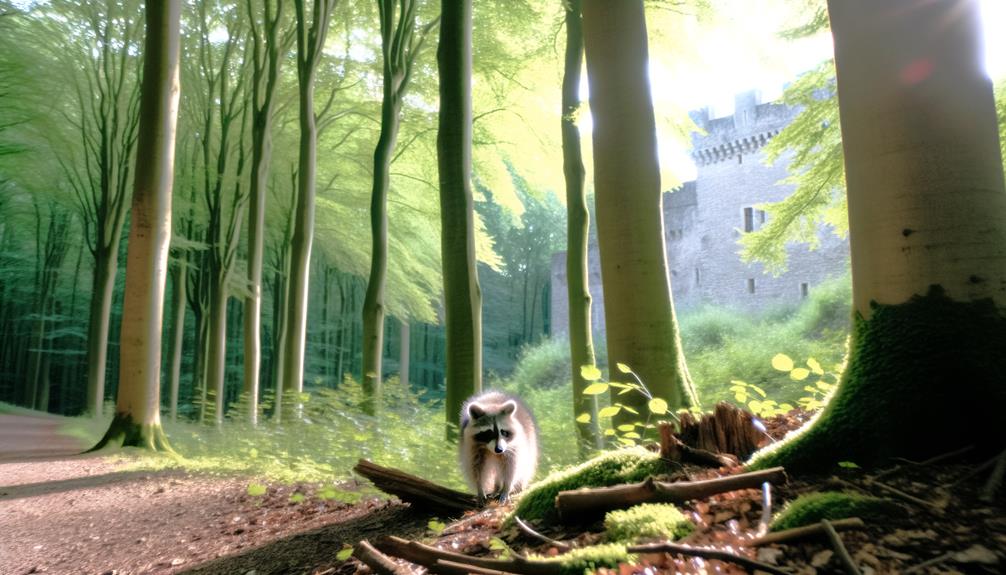How Did Raccoons Get to Europe: A Historical Guide
Raccoons were introduced to Europe in the early 20th century, primarily through the fur trade and as exotic pets. Economic interests and fascination with North American wildlife led to their importation.
Escapes from fur farms and the release of unwanted pets resulted in the establishment of wild populations. Their adaptability allowed them to thrive in European environments, leading to a significant spread across forests, wetlands, and urban areas.
This expansion has had detrimental effects on local biodiversity, predating on native species and competing with local fauna. Learn how these developments have prompted current management strategies to control their impact.

Key Takeaways
- Raccoons were introduced to Europe for fur farming in the early 20th century.
- Exotic pet trade contributed to their presence in Europe.
- Escapes from fur farms and inadequate containment led to wild populations.
- Deliberate releases in the 1930s helped establish raccoon populations.
- Adaptability and natural dispersal enabled raccoons to thrive and spread.
Early European Encounters
In the early 20th century, raccoons were initially brought to Europe primarily for fur farming and as exotic pets. This introduction was largely driven by their perceived economic value and their novelty appeal. By analyzing historical records, it becomes evident that these early encounters were facilitated by increased global trade and the fascination with North American wildlife.
European aristocracy and affluent individuals sought exotic animals to display, furthering the spread of raccoons. However, inadequate containment and management practices led to some raccoons escaping into the wild. This unintentional release initiated their establishment in non-native ecosystems.
Understanding these early encounters provides insight into the challenges of managing introduced species and underscores the importance of responsible wildlife trade practices.
Importation for Fur Trade
The importation of raccoons to Europe began in the early 20th century, largely driven by the burgeoning demand for their fur.
European furriers recognized the high quality and popularity of raccoon pelts, prompting increased trade and transport of these animals across the Atlantic.
This commercial activity notably contributed to the establishment of raccoon populations in various parts of Europe.
Early 20th Century Trade
Driven by the lucrative demand for raccoon pelts, early 20th-century traders increasingly imported these animals into Europe, greatly impacting local biodiversity and economies. The primary motivation for this trade was economic gain, as raccoon fur was highly valued.
Traders capitalized on this demand by capturing raccoons in North America and transporting them across the Atlantic. Upon arrival, raccoons were either released into the wild or kept in captivity for fur farming. This influx of non-native species led to unforeseen ecological consequences, including competition with indigenous wildlife and the potential spread of diseases.
Economically, the trade created new business opportunities but also disrupted existing markets and local ecosystems, necessitating regulatory responses from European authorities.
Demand for Raccoon Fur
A burgeoning fascination with raccoon fur among European fashion houses in the early 20th century catalyzed a significant increase in the importation of these animals. The luxurious texture and durability of raccoon fur made it a coveted material for high-end garments and accessories.
Consequently, entrepreneurs saw an opportunity to meet this growing demand by importing raccoons from North America. This trade was not merely transactional but involved complex logistics, including the capture, transport, and acclimatization of raccoons in European environments.
Additionally, the fur trade's economic incentives led to the establishment of breeding programs, further embedding raccoons into European ecosystems. Understanding this importation process reveals the intricate interplay between fashion trends and wildlife distribution, highlighting the fur trade's lasting ecological impact.
Escapes and Released Pets
The proliferation of raccoons in Europe can be largely attributed to incidents of zoo escapes and the release of pet raccoons by private owners. Zoos across the continent have reported several instances where raccoons have managed to escape confinement, thereby entering the wild.
Additionally, pet raccoons, often released by owners unable to care for them, have further contributed to the establishment of feral populations.
Zoo Escapes
Incidents of raccoons escaping from zoos and being released as pets have greatly contributed to the establishment of wild raccoon populations in various parts of Europe. The adaptability and opportunistic behavior of raccoons allow them to thrive in diverse environments, making zoo escapes particularly consequential. Notable instances include the escape of raccoons from Berlin's Friedrichsfelde Zoo in 1934 and similar occurrences in other European countries. These events, compounded by inadequate containment measures, facilitated the spread of these invasive species.
| Year | Location | Incident Description | Impact on Population |
|---|---|---|---|
| 1934 | Berlin, Germany | Escape from Friedrichsfelde Zoo | Established local populations |
| 1950s | Various German Zoos | Multiple escapes reported | Spread across Germany |
| 1970s | France | Escape from local zoos | Regional population growth |
| 1980s | Switzerland | Isolated zoo escapes | Formation of wild colonies |
Pet Releases
Due to the increasing trend of keeping raccoons as exotic pets, numerous instances of intentional releases and accidental escapes have greatly bolstered their populations across Europe. Owners often underestimate the challenges of caring for raccoons, leading to their release into the wild.
Additionally, raccoons are adept escape artists, frequently breaking free from enclosures. Studies indicate that these released or escaped raccoons have readily adapted to European environments, exploiting urban and rural areas for food and shelter.
The proliferation of raccoons poses significant ecological risks, including the disruption of local wildlife and potential transmission of diseases. Addressing this issue necessitates stronger regulations on pet ownership and public education on the responsibilities of exotic pet care.
Establishing Wild Populations
Initially introduced to Europe in the 1930s, raccoons began establishing wild populations through both deliberate releases and accidental escapes from captivity. These events occurred primarily in Germany, where raccoons were imported for fur farming and private zoos.
During World War II, disruptions led to many of these animals escaping or being released. The species, adaptable and opportunistic, quickly found suitable habitats in European forests, wetlands, and urban areas. By the 1950s, established populations were observed, spreading progressively across neighboring countries.
Monitoring data indicates that raccoons' reproductive success and lack of natural predators facilitated their rapid proliferation. Consequently, these populations have expanded significantly, necessitating management strategies to mitigate ecological and human-wildlife conflicts.
Ecological Adaptability
The rapid establishment and proliferation of raccoon populations in Europe can be attributed to the species' remarkable ecological adaptability. This adaptability allows them to thrive in diverse environments ranging from dense forests to urban landscapes. Raccoons possess a highly flexible diet, consuming everything from fruits and insects to human garbage, which enables them to survive in a variety of habitats.
Their dexterous front paws and intelligence facilitate efficient foraging and problem-solving. Additionally, raccoons exhibit nocturnal behavior, reducing competition with diurnal species and minimizing predation risks. Their ability to exploit anthropogenic resources, such as food waste and shelter in abandoned buildings, further underscores their adaptability.
This ecological plasticity is crucial for their successful establishment in non-native regions like Europe.
Spread Across Europe
Raccoons first began spreading across Europe following their introduction in the mid-20th century, facilitated by deliberate releases and accidental escapes from fur farms and private collections.
Initially confined to small, isolated populations, raccoons soon demonstrated their remarkable adaptability by thriving in a variety of habitats. Their range expanded through natural dispersal and human-mediated transportation.
By the late 20th century, populations had established strongholds in Germany and neighboring countries. Subsequent decades saw further spread into France, Belgium, and the Netherlands. Monitoring data reveals a steady increase in population density and geographic distribution.
Contributing factors include mild winters, abundant food sources, and lack of natural predators, enabling raccoons to colonize both urban and rural environments effectively.
Impacts on Native Species
Raccoons' introduction to European ecosystems has led to significant ecological repercussions, particularly through their predation on native fauna and competition for resources. These omnivores have adversely impacted bird populations by raiding nests and consuming eggs. Amphibians and small mammals have also seen population declines due to raccoon predation. Moreover, raccoons compete with native species such as hedgehogs and badgers for food, thereby disrupting local biodiversity.
| Impact | Native Species Affected |
|---|---|
| Predation on nests | Birds (e.g., blackbirds) |
| Predation on amphibians | Frogs, newts |
| Resource competition | Hedgehogs, badgers |
The presence of raccoons has led to a cascade of negative effects, eroding the stability and health of various European habitats.
Current Management Efforts
To mitigate the ecological impact of raccoons, various European countries have implemented targeted management strategies. In Germany, regulated hunting seasons and trapping are employed to reduce raccoon numbers. Public awareness campaigns educate citizens on how to avoid attracting raccoons. In France, authorities have introduced sterilization programs to curb population growth. Habitat protection measures include the installation of raccoon-proof barriers around sensitive areas and the restoration of habitats to bolster native species. Monitoring and research initiatives are also in place to track raccoon populations and assess the effectiveness of management strategies.
Collectively, these efforts aim to balance raccoon control with ecological preservation and community engagement.
Conclusion
The introduction of raccoons to Europe, initially for the fur trade and later as escaped or released pets, has resulted in their widespread establishment across the continent. Remarkably adaptable, these mammals have notably impacted native species and ecosystems.
Current management efforts seek to mitigate these effects. An astonishing statistic is that in Germany alone, the raccoon population is estimated to exceed one million, highlighting the urgency and scale of the ongoing ecological challenge.






